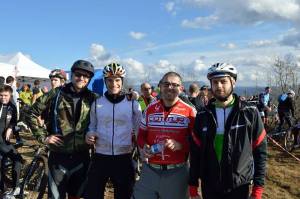The point on 27,5+
 After having used a 27,5+ hardtail I assembled on purpose, there is some experience you might find useful I have gathered.
After having used a 27,5+ hardtail I assembled on purpose, there is some experience you might find useful I have gathered.
As you might guess, the advantage of such big tyres on hardtails are many: comfort, control, traction and good ole’ downright fun. You know hardtails are fun, and sometimes much more fun than fullsussers*, and not being battered to death makes them even funnier. Problem is, the industry started with the plus standard on bikepacking bikes (loners who don’t like other human beings or comforts, it seems*) and trail bikes (some kind of XCish nice behaving bike for easily scared blokes). But, I like to go search for troubles: hyper tech descents, jumps here and there, trying to keep up with full suss riders on downhills. And from that point of view, not many bikes have the right geometries.
The relationship with wheels is completely different than with regular ones: such big tyres are protecting the rim, and the rim is very wide. On a regular wheelset, you want strength from the rim because it’s gonna get battered, but on a plus wheel you have a very wide rim and tyre already, so they don’t need to be as strong.
On the rim side, my first one is the Wtb Scraper at the rear, followed by the SunRingle’ Malefut at the front: where the first is cumbersome, heavy and doublewall, the second is light with big holes, quick and singlewall. The second has won without any doubts. Not only the Wtb is uselessly heavy, the SunRingle’ has survived many more things it’s huge holes and lightweight would suggest, but it makes changing tyres incredibly hard. The next step, as time and money will let me, will be of course carbon rims because they will be so little stressed (low pressure, wide profile).
This takes us to the rubbers: they need to be tough enough to be used at low pressures. Of course, with such amount of the stuff, you need to go tubeless to avoid the that huge inner tube of scratching around and robbing you of forward motion. And then you discover that the vast majority of tyres is too light. You need a beast of about a kilo, anything less is gonna suicide itself on proper hard riding. I have destroyed a Specialized Ground Control of 890gr and a Schwalbe Racing Ralph of 780gr, mainly on rocks or downhilling. A VeeTyres Crown Jewel, with its dual ply, seems clearly to have solved the problems.
So, up to this point, fat and tough tyres with light rims is good. The opposite is very bad (it’s what the majority of the industry is doing, actually).
The final act is: tubeless strip. And here probably we can see how much rushed the plus size has been to the market. The Wtb had a regular tubeless strip, leaving me to play with various types of tape to patch it up, while the SunRingle’ said to sport its demifat elastic tubeless strip. That was in fact a rigid piece of crackable plastic, that cracked as soon as I made the rim tubeless. Still managed to patch it up. At the moment, some strips are popping up, like Effetto Mariposa (http://www.effettomariposa.eu/en/products/caffelatex-tubeless-fat-strip/)
To finish it all yes, a 27,5+ is the right bike to get really rowdy offroad but be careful of what you are buying. There is no bike at the moment perfect out of the box and it’s better to follow the path of custom assembly.
*Strictly personal opinions, based on observation of local riders. Feel free to drop a couple of lines to insult me.

















